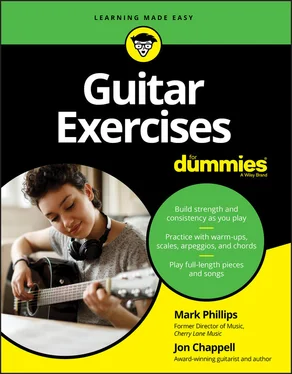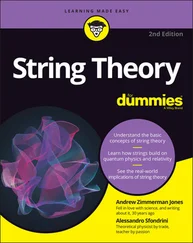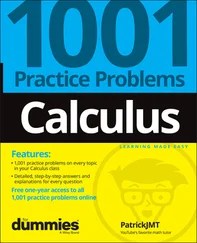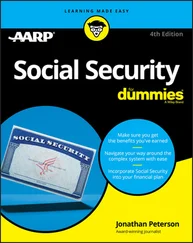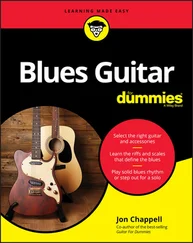6 Part 4: Chords and Additional Exercises Chapter 13: Building Finger Independence with Chord Exercises Practicing Inversion Patterns Playing Chord Progressions Practicing Pieces That Use Chord Progressions Chapter 14: Developing Strength and Speed by Playing Single-Note Exercises Moving Across the Neck Moving Along the Neck
7 Part 5: The Part of Tens Chapter 15: Ten Tips for Maximizing Your Practice Time Establish Your Practice Place Define Your Practice Time (and Stick to It) Establish Objectives for Your Practice Sessions Keep Your Accessories Handy Get Your Head in the Game Warm Up Your Hands and Fingers Start Slow and Work Your Way Up Isolate Difficult Passages Play Different Guitars Join the Club Chapter 16: Ten Ways to Improve Your Musicianship Get with the Rhythm Familiarize Yourself with Pitch Discover Harmony Perform Live for a Crowd Compose Your Own Melody and Improvise a Bit Train Your Ear to Hear Polish Your Playing with Expression Listen to Lots of Music Watch a Performer’s Body Language Test Yourself by Teaching Someone Else
8 Appendix A: How to Use the Website Relating the Text to the Website Using the Website Tracks on the Website Troubleshooting
9 About the Authors
10 Advertisement Page
11 Connect with Dummies
12 End User License Agreement
1 Chapter 1FIGURE 1-1: An example of guitar tablature, or tab .FIGURE 1-2: The anatomy of a chord diagram.FIGURE 1-4: Rhythm slashes.FIGURE 1-3: The anatomy of a neck diagram.
2 Chapter 2FIGURE 2-1: “Across the neck” chromatic warm-up.FIGURE 2-2: Diagonal chromatic warm-up.FIGURE 2-3: “Across the neck” whole step warm-up.FIGURE 2-4: Diagonal whole step warm-up.FIGURE 2-5: Open major chord warm-up.FIGURE 2-6: Major barre chord warm-up.
1 Cover
2 Table of Contents
3 Begin Reading
1 iii
2 iv
3 1
4 2
5 3
6 4
7 5
8 7
9 8
10 9
11 10
12 11
13 12
14 13
15 14
16 15
17 16
18 17
19 19
20 20
21 21
22 22
23 23
24 24
25 25
26 26
27 27
28 28
29 29
30 30
31 31
32 32
33 33
34 34
35 35
36 36
37 37
38 38
39 39
40 40
41 41
42 42
43 43
44 44
45 45
46 46
47 47
48 48
49 49
50 50
51 51
52 52
53 53
54 54
55 55
56 56
57 57
58 58
59 59
60 60
61 61
62 62
63 63
64 64
65 65
66 66
67 67
68 68
69 69
70 70
71 71
72 72
73 73
74 74
75 75
76 76
77 77
78 78
79 79
80 80
81 81
82 82
83 83
84 84
85 85
86 86
87 87
88 88
89 89
90 90
91 91
92 92
93 93
94 94
95 95
96 96
97 97
98 98
99 99
100 100
101 101
102 102
103 103
104 104
105 105
106 106
107 107
108 108
109 109
110 110
111 111
112 112
113 113
114 114
115 115
116 116
117 117
118 118
119 119
120 120
121 121
122 122
123 123
124 124
125 125
126 126
127 127
128 128
129 129
130 131
131 132
132 133
133 134
134 135
135 136
136 137
137 138
138 139
139 140
140 141
141 142
142 143
143 144
144 145
145 146
146 147
147 148
148 149
149 150
150 151
151 153
152 154
153 155
154 156
155 157
156 158
157 159
158 160
159 161
160 162
161 163
162 164
163 165
164 166
165 167
166 168
167 169
168 170
169 171
170 172
171 173
172 174
173 175
174 176
175 177
176 178
177 179
178 180
179 181
180 182
181 183
182 184
183 185
184 186
185 187
186 188
187 189
188 190
189 191
190 192
191 193
192 194
193 195
194 196
195 197
196 198
197 199
198 201
199 202
200 203
201 204
202 205
203 207
204 208
205 209
206 211
207 212
208 213
209 214
210 215
211 217
212 219
213 221
214 222
Playing guitar is an activity that has so many terrific qualities. It’s artistic, expressive, inspiring, therapeutic, and even cathartic. Nothing beats the blues like playing the blues. Guitar playing is an effective and natural means for relieving stress. But it’s like sports, games, and any other physical endeavors requiring strength, speed, stamina, and coordination: The more you practice, the better you become at it. And the better you are at guitar playing, the more successful your music making efforts will be.
One of the best ways to become more accomplished in the purely physical aspects of playing guitar is to exercise your fingers — the main agents of guitar playing — to get them conditioned. And that’s what Guitar Exercises For Dummies focuses on. By picking up this book, you’ve agreed to send your digits off to spring training. After going through the pages of Guitar Exercises For Dummies, your fingers will come out faster, nimbler, stronger, and more confident, and they’ll be better team players as well. And because music involves the mind as well as the body, we give you tips and advice that will get you thinking. As Yogi Berra said, “Ninety percent of the game is half mental,” so we work on strengthening your gray matter, too.
In this book, we give you exercises that make sense in a musical context; that way, you learn useful things like scales, arpeggios, and chords — all of which are incorporated into the songs and pieces you play. Your brain is the coach, and the following pages are your playbook. After putting your fingers through the workout regimen of Guitar Exercises For Dummies , they will be lean, mean playing machines.
Because there are real physical aspects to playing guitar, we recognize that what’s true for guitar playing is also true for swimming, running, golf, or Guitar Hero: You don’t get better unless you practice. And practice, in terms of the physical conditioning we talk about here, is known as exercise. Exercise is an efficient way for your body to practice moving specific parts in the way a given activity requires. Football players lift weights to become stronger and more powerful against opponents on the gridiron. Guitar players practice scales to become more facile at playing melodies on the fretboard.
This book is a reference you can jump into and out of at will. In other words, you don’t have to read from cover to cover. Just head to the table of contents to find what you need to practice at any given moment. But it’s worth noting that we present scales, arpeggios, and chords in a logical, organized way that allows you to train your fingers and learn the musical vocabulary that comes up time and again in real-life musical situations. We explain the exercise presentation most thoroughly in Chapters 3and 4to get you up and playing, and then in later chapters we provide more great practice opportunities but with less commentary (we can almost hear you sighing with relief). Also notice that Chapters 3through 12are grouped in pairs, where the first, odd-numbered chapter in the pair introduces a new concept (such as a scale or arpeggio pattern) and the second chapter has you applying that concept in a series of exercises. Both chapters in each pair include helpful exercises, but to get the most out of these chapters and be sure you can easily follow along, you may find that it’s best to tackle these pairs starting with the odd-numbered chapter, where we take a little more time to explain things.
Читать дальше
